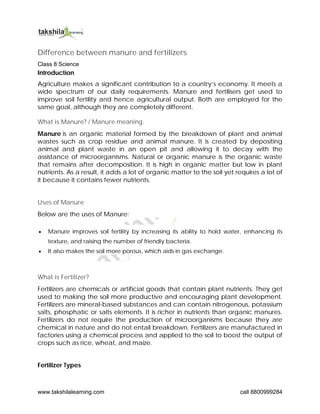
Difference between manure and fertilizers.pdf
- 1. www.takshilalearning.com call 8800999284 Difference between manure and fertilizers Class 8 Science Introduction Agriculture makes a significant contribution to a country’s economy. It meets a wide spectrum of our daily requirements. Manure and fertilisers get used to improve soil fertility and hence agricultural output. Both are employed for the same goal, although they are completely different. What is Manure? / Manure meaning. Manure is an organic material formed by the breakdown of plant and animal wastes such as crop residue and animal manure. It is created by depositing animal and plant waste in an open pit and allowing it to decay with the assistance of microorganisms. Natural or organic manure is the organic waste that remains after decomposition. It is high in organic matter but low in plant nutrients. As a result, it adds a lot of organic matter to the soil yet requires a lot of it because it contains fewer nutrients. Uses of Manure Below are the uses of Manure: Manure improves soil fertility by increasing its ability to hold water, enhancing its texture, and raising the number of friendly bacteria. It also makes the soil more porous, which aids in gas exchange. What is Fertilizer? Fertilizers are chemicals or artificial goods that contain plant nutrients. They get used to making the soil more productive and encouraging plant development. Fertilizers are mineral-based substances and can contain nitrogenous, potassium salts, phosphatic or salts elements. It is richer in nutrients than organic manures. Fertilizers do not require the production of microorganisms because they are chemical in nature and do not entail breakdown. Fertilizers are manufactured in factories using a chemical process and applied to the soil to boost the output of crops such as rice, wheat, and maize. Fertilizer Types
- 2. www.takshilalearning.com call 8800999284 Fertilizers can be of two types: Organic fertilizers: Organic fertilisers are manufactured from natural elements such as decomposed plant debris, bone, seaweed, peat, and so on. Synthetic fertilizers: Synthetic fertilisers are made up of compounds that dissolve rapidly in water and are readily absorbed by plants. Explain how fertilizers are different from manure Manure vs. Fertilizer The following are the primary distinctions between manure and fertiliser: Manure Fertilizer It is made by depositing plant and animal wastes in pits in an open area. It is created in factories by a chemical process. It is an organic compound formed by the breakdown of plant or animal faeces. It is a synthetic or industrially- produced substance that contains plant nutrients. Because it is probably insoluble in water, it is slowly absorbed by the soil and plants. It dissolves easily in water and is promptly absorbed by the soil and plants. It provides fewer plant nutrients than fertilisers. It contains more plant nutrients than manure. It enriches the soil with humus. It does not add humus to the soil. It is not harmful to the soil and, in the long term, enhances soil quality. Excessive fertiliser application can degrade soil quality and damage soil organisms. It is cost-effective since it may be simply made from decaying plant and animal waste. It is expensive because it is manufactured in factories by machines. FAQs (Frequently Asked Questions) What are manure and fertiliser? Manure: Organic waste collected organically from decaying plants and animals is referred to as manure. It is also derived from the faeces of animals and humans, as well as from household trash such as vegetable peels.
- 3. www.takshilalearning.com call 8800999284 Fertilizer: Fertilizer is a natural or chemically synthesized ingredient that is applied to soil to improve its productivity as well as fertility. Fertilizer or manure: which is preferable? Manure is superior to fertiliser. Manure is derived organically and adds much more to the soil than just nutrients. They boost soil fertility by increasing the activity of bacteria in the soil. Fertilisers, on the other hand, damage these bacteria and create health problems in consumers since they are chemically synthesised. Can manure be used in organic farming? Manure improves the soil. It provides nutrients to the plants and is an important fertiliser in organic farming. As a result, it is permissible under National Organic Program Standards. What do you mean by organic fertiliser? Human and animal excreta, as well as vegetable waste, are used to make organic fertilisers. The most efficient organic fertilisers are made from animal waste, slurry, and manure from meat production. Write some similarities between manure and fertilizers. Some similarities between manure and fertilizers are: Manure and fertilisers both contribute to boosting crop yield. They nourish the plants and aid in their growth. They improve the soil’s fertility by enriching it. State the difference between Manure and Fertilizer. The following are the primary distinctions between manure and fertiliser: 1. Manure is made by depositing plant and animal wastes in pits in an open area while fertilizers get created in factories by a chemical process.
- 4. www.takshilalearning.com call 8800999284 2. Manure is an organic compound formed by the breakdown of plant or animal faeces while fertilizer is a synthetic or industrially-produced substance that contains plant nutrients. 3. Manure gets absorbed by soil and plants because it is insoluble in water while fertilizers dissolve easily in water and get absorbed by soil and plants promptly. 4. Manure is not harmful to the soil and, in the long term, enhances soil quality while application of too much fertiliser can degrade soil quality and damage soil organisms. 5. Manure is cost-effective since it is simply made from decaying plant and animal waste while fertilizer can be really expensive since it gets manufactured in factories by machines.
